SIU Director’s Report - Case # 17-OVI-246
Warning:
This page contains graphic content that can shock, offend and upset.
Contents:
Mandate of the SIU
The Special Investigations Unit is a civilian law enforcement agency that investigates incidents involving police officers where there has been death, serious injury or allegations of sexual assault. The Unit’s jurisdiction covers more than 50 municipal, regional and provincial police services across Ontario.
Under the Police Services Act, the Director of the SIU must determine based on the evidence gathered in an investigation whether an officer has committed a criminal offence in connection with the incident under investigation. If, after an investigation, there are reasonable grounds to believe that an offence was committed, the Director has the authority to lay a criminal charge against the officer. Alternatively, in all cases where no reasonable grounds exist, the Director does not lay criminal charges but files a report with the Attorney General communicating the results of an investigation.
Information restrictions
Freedom of Information and Protection of Personal Privacy Act (“FIPPAâ€)
Pursuant to section 14 of FIPPA (i.e., law enforcement), certain information may not be included in this report. This information may include, but is not limited to, the following:
- Confidential investigative techniques and procedures used by law enforcement agencies; and
- Information whose release could reasonably be expected to interfere with a law enforcement matter or an investigation undertaken with a view to a law enforcement proceeding.
Pursuant to section 21 of FIPPA (i.e., personal privacy), protected personal information is not included in this document. This information may include, but is not limited to, the following:
- subject officer name(s)
- witness officer name(s)
- civilian witness name(s)
- location information
- witness statements and evidence gathered in the course of the investigation provided to the SIU in confidence and
- other identifiers which are likely to reveal personal information about individuals involved in the investigation
Personal Health Information Protection Act, 2004 (“PHIPAâ€)
Pursuant to PHIPA, any information related to the personal health of identifiable individuals is not included.
Other proceedings, processes, and investigations
Information may have also been excluded from this report because its release could undermine the integrity of other proceedings involving the same incident, such as criminal proceedings, coroner’s inquests, other public proceedings and/or other law enforcement investigations.
Mandate engaged
The Unit’s investigative jurisdiction is limited to those incidents where there is a serious injury (including sexual assault allegations) or death in cases involving the police.
“Serious injuries†shall include those that are likely to interfere with the health or comfort of the victim and are more than merely transient or trifling in nature and will include serious injury resulting from sexual assault. “Serious Injury†shall initially be presumed when the victim is admitted to hospital, suffers a fracture to a limb, rib or vertebrae or to the skull, suffers burns to a major portion of the body or loses any portion of the body or suffers loss of vision or hearing, or alleges sexual assault. Where a prolonged delay is likely before the seriousness of the injury can be assessed, the Unit should be notified so that it can monitor the situation and decide on the extent of its involvement.
This report relates to the SIU’s investigation into the serious injuries reportedly sustained by a 38-year-old male following a police pursuit on September 7, 2017.
The investigation
Notification of the SIU
At approximately 10:15 a.m. on September 7, 2017, the Niagara Regional Police Service (NRPS) notified the SIU of the serious injuries sustained by the 38-year-old Complainant as a result of a single motor vehicle collision following a brief police pursuit.
The NRPS reported that on September 7, 2017 at 8:57 a.m., the police were contacted by the owner of a local scrap yard who had just been approached by two men who offered to sell him a pickup truck, trailer, and lawn maintenance equipment. The caller described the men as being under the influence of intoxicants and supplied the license plate number of the truck to the police.
Shortly thereafter, the Subject Officer (SO) located the truck and trailer and initiated a traffic stop. The vehicle failed to stop and left the roadway, violently colliding with a tree. The Complainant was partially ejected from the vehicle and was later flown to hospital where he was diagnosed with rib fractures.
The Team
Number of SIU Investigators assigned: 3
Number of SIU Forensic Investigators assigned: 3
Number of SIU Collision Reconstructionists assigned: 1
On Thursday, September 7, 2017, three SIU investigators, a collision reconstructionist, and three forensic investigators (FI) initiated an investigation in Niagara Region. The scene was photographed, measured and a diagram was prepared. The area was canvassed for possible surveillance video, but to no avail, as the scene was in a remote part of the Region. Civilian witnesses were located and interviewed and medical records were obtained and reviewed on consent.
Complainant:
38-year-old male interviewed, medical records obtained and reviewed
Civilian Witnesses
CWÂ #1 Interviewed
CWÂ #2 Unavailable for interview, but his report was obtained and reviewed
Witness Officers
WOÂ #1 Interviewed, notes received and reviewed
WOÂ #2 Interviewed, notes received and reviewed
WOÂ #3 Interviewed, notes received and reviewed
Subject Officers
SO #1 Interviewed, but declined to submit notes, as is the subject officer’s legal right.
Incident narrative
On the morning of September 7, 2017, the Complainant and Civilian Witness (CW) #1 tried to sell a stolen pickup truck, trailer, and equipment to the owner of a salvage yard. The Complainant and CW #1 drove into the lot of the salvage yard through a driveway which was meant to be used as an exit and became stuck. An employee managed to free the truck but the Complainant then drove over an industrial scale. The owner of the salvage yard contacted the police to report that the Complainant and CW #1, who he believed to be under the influence of narcotics, were attempting to sell him stolen property.
Police officers from the NRPS responded and searched for the pickup truck and trailer. The SO and Witness Officer (WO)Â #1 were the first to locate the stolen pickup truck and followed it onto Beechwood Road, with the SO in the lead. The truck veered off the roadway to its right and travelled along the ditch for a great distance, before eventually striking a tree and coming to rest. The SO described the motion of the truck and trailer as moving from side to side as it moved along the ditch.
Subsequent investigation confirmed that the SO was 52 metres behind the pickup truck when it struck the tree and that the speeds of his police vehicle ranged from 52 to 99Â km/h during the pursuit, in a posted 80Â km/h zone. SIU FIs verified that the police vehicle operated by the SO did not at any time come into physical contact with the pickup truck. No other vehicles were on Beechwood Road at the time, nor were pedestrians anywhere near the collision scene. Road and weather conditions were good.
Upon the arrival of paramedics, the Complainant had to be administered multiple injections of Narcan on the ground, in the helicopter, and at hospital, to counteract the drugs in his system.
Nature of Injuries / Treatment
The Complainant was examined at hospital on September 8, 2017, after being treated with Narcan for an apparent drug overdose. He was then diagnosed as having received one fractured rib on each side and a bruised lung. He was prescribed pain killers for the rib injuries and is expected to fully recover.
Evidence
The Scene
SIU Forensic Scene Examination
Beechwood Road is a rural road with farmland on either side. It is a straight, two lane, paved asphalt roadway with grass shoulders and shallow ditches and runs in a north and south direction. The posted speed limit is 80Â km/h and the road was dry and in good condition.
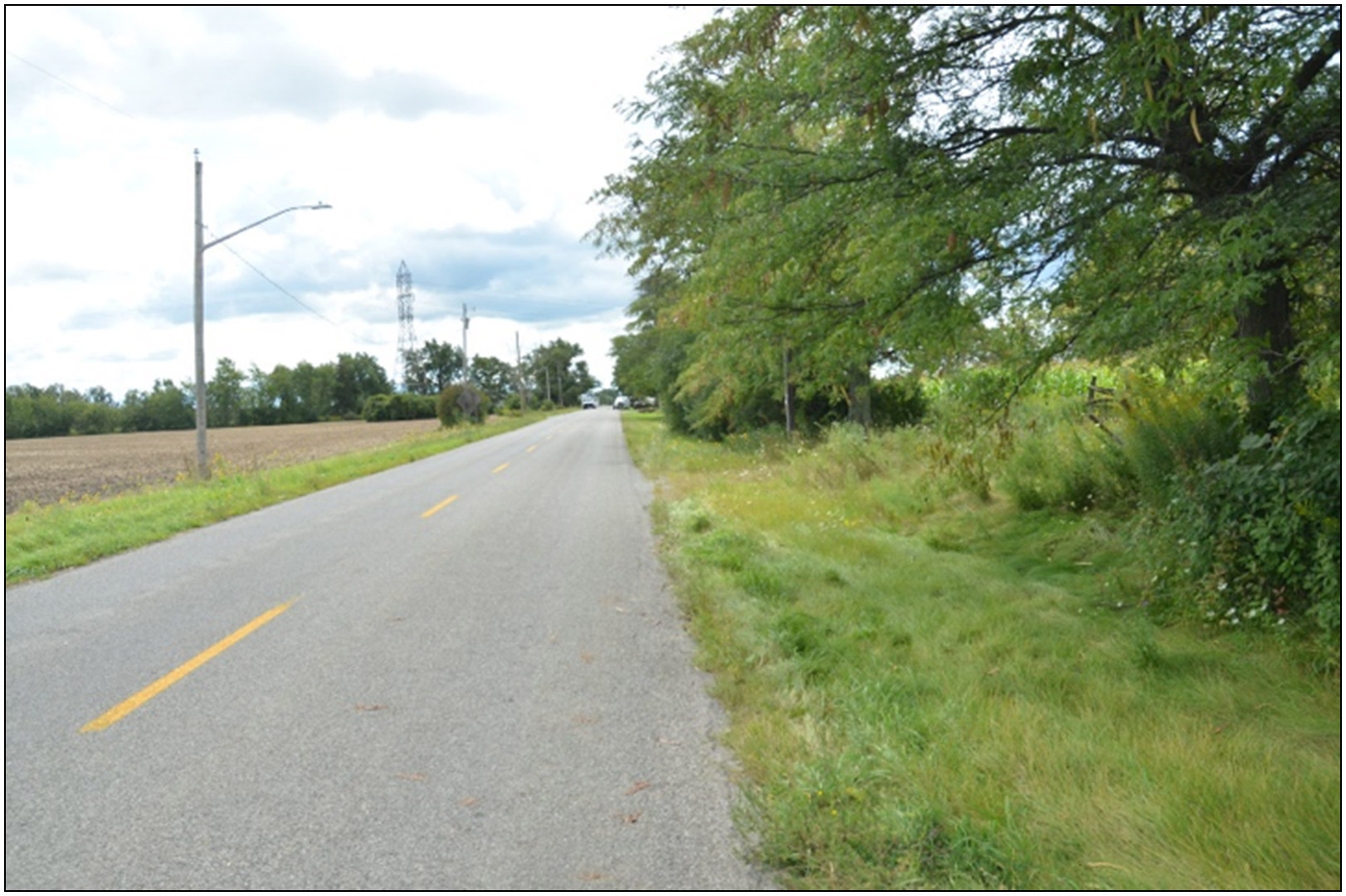
The collision occurred mid-block, directly in front of a house.
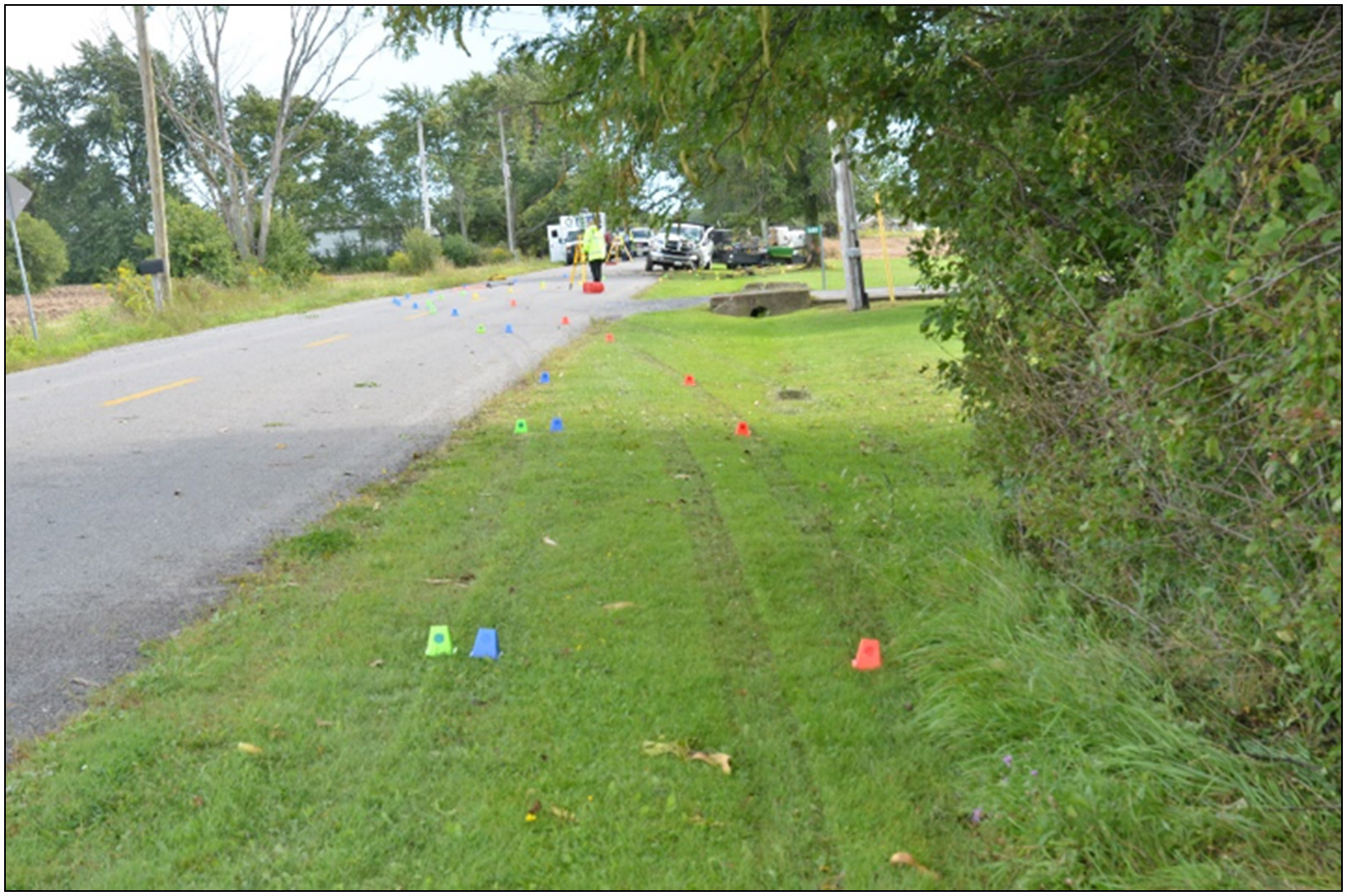
About 130 metres north of the tree that was struck, tire marks were located on the grass shoulder of the road on the west side. The tire marks re-entered the travelled portion of the road and curved towards the east shoulder, then back towards the west shoulder, and eventually to the tree that was struck.
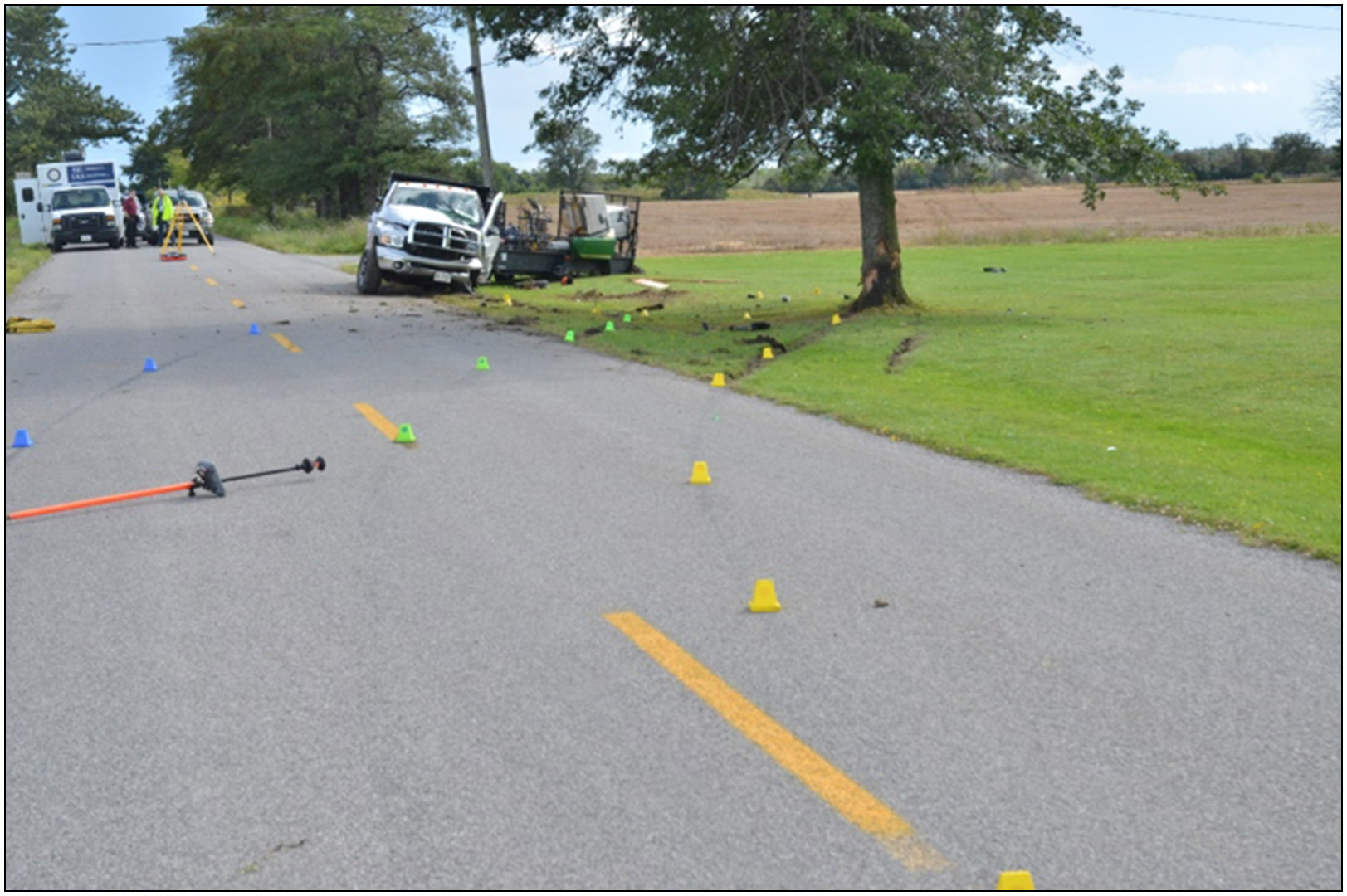
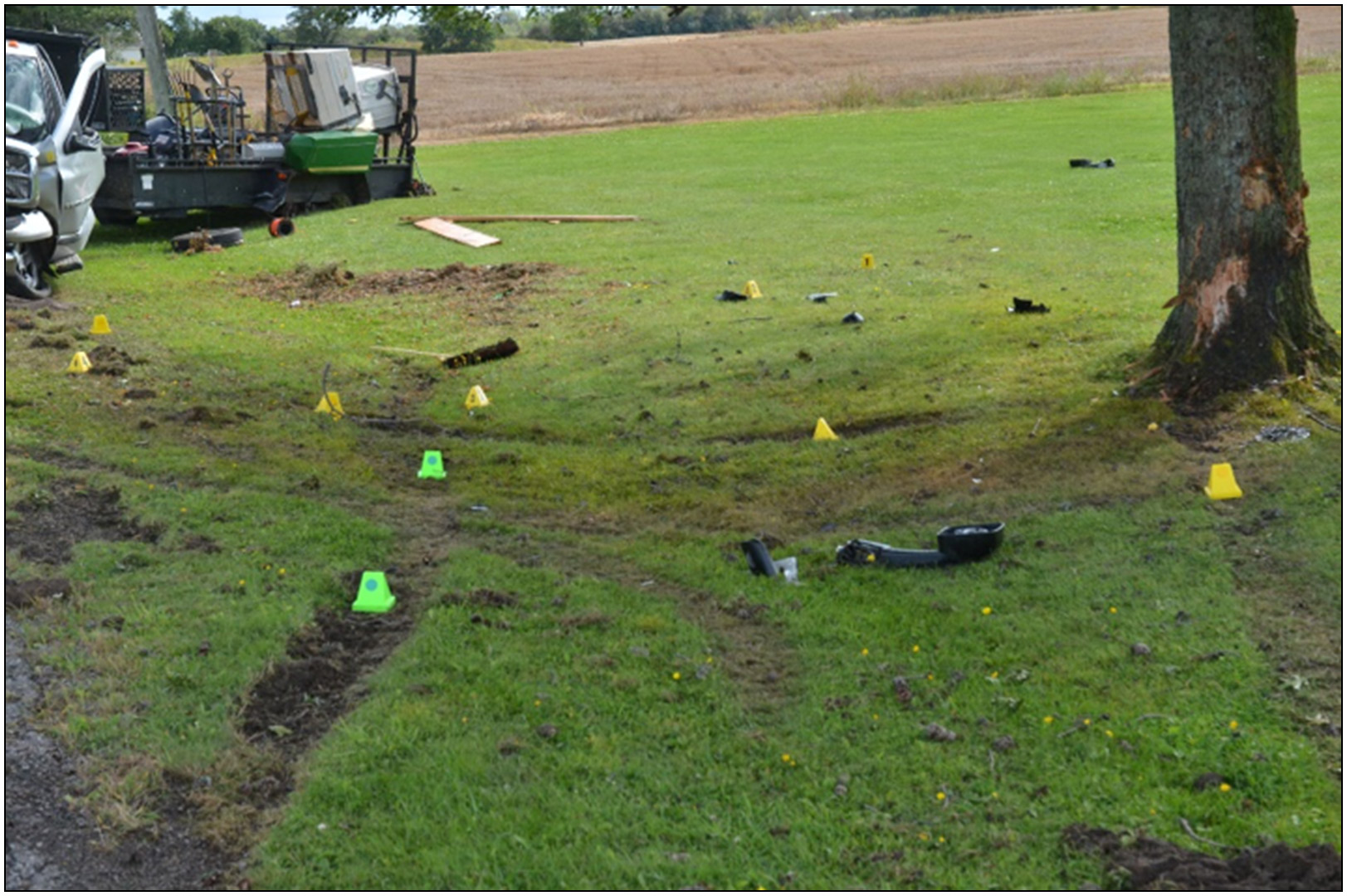
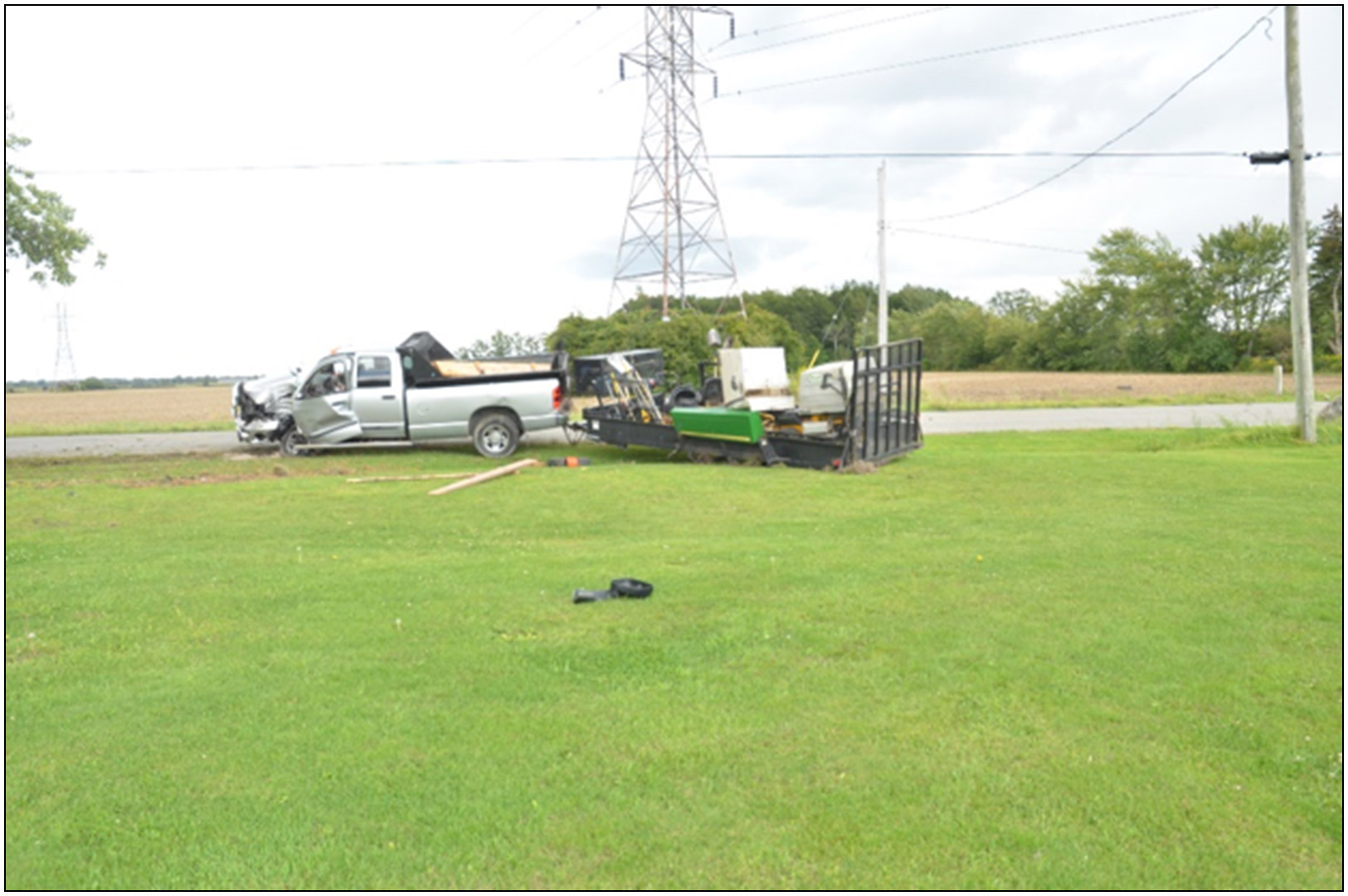
Scene Diagram
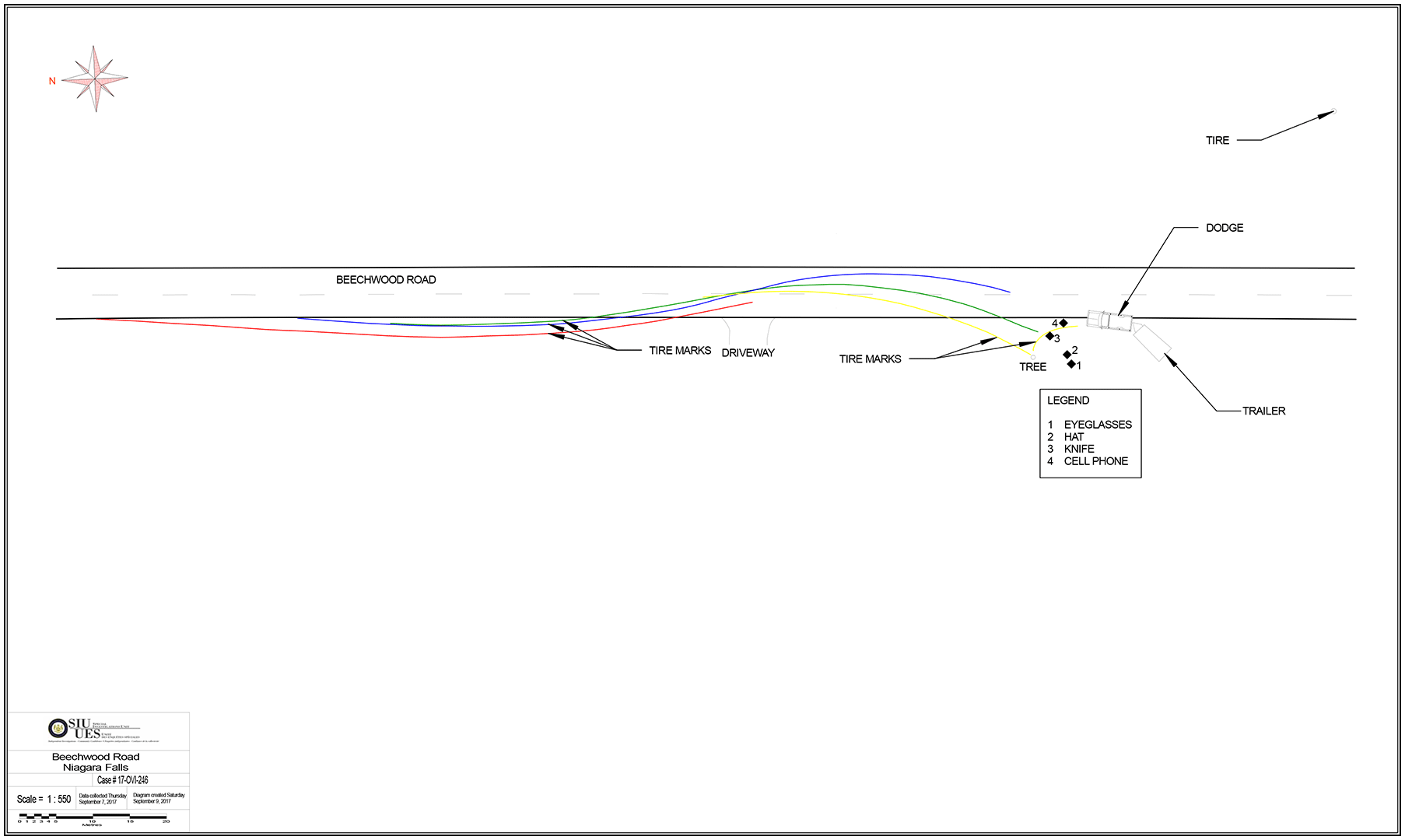
Physical Evidence
AVL / GPS Data
The SIU obtained the GPS data from the NRPS and it was reviewed by an SIU FI. The data indicated that at the time of the truck’s impact with the tree, the SO was 52 metres (170 feet) behind the truck, consistent with his estimate of between 200 and 300 feet. The SO first encountered the stolen truck at 8:44:18 a.m., at the intersection of Beaverdams Road and Beechwood Road. That intersection is controlled by a four-way overhead red flashing stop light. Beechwood Road is two lanes, one each for north and south traffic. The posted speed limit is 80 km/h and there are no other intersecting roads between Beaverdams Road and the impact site. There are two residences on Beechwood Road at this juncture but no other impediments or safety concerns.
The time/distance travelled, and average speed of the SO, at the four points that registered on the GPS chart from the intersection of Beaverdams Road southbound to the point where the pickup truck impacted with the tree are indicated below. These speeds calculate to an average speed traveled by the SO’s police vehicle at 58.75 km/h.
| Time | Distance Travelled | Speed |
|---|---|---|
| 8:44:18-8:44:31 | 190.10 metres | 52 Km/h |
| 8:44:31-8:44:41 | 216.48 metres | 77 Km/h |
| 8:44:41-8:44:52 | 303.44 metres | 99 Km/h |
| 8:44:52-8:45:03 | 190.21 metres | 13 Km/h |
Forensic Evidence
No submissions were made to the Centre of Forensic Sciences.
Expert Evidence
The Collision Reconstruction Report found as follows:
The physical evidence at the scene was consistent with the following. The tire marks indicated that the involved vehicle had been traveling southbound on Beechwood Road and drove onto the grass shoulder and into the shallow ditch on the west side of the road.
Swaying of the trailer, typically due to excessive speed, likely commenced prior to the first tire mark on the west shoulder and led to the driver losing control and entering onto the grass shoulder. Even if the driver of the pickup was attempting to brake or decelerate, the pushing action of the trailer would have forced the pickup truck into its clockwise rotation.
When the pickup truck began rotating clockwise, the trailer swayed to the right, forcing an increasingly pronounced sway and back to the west side of the road in front of [# of house] leading with the driver’s side of the pickup truck. The pickup truck left the road and violently collided with the tree in the area of the front driver’s side, near the front wheel.
The cause of this collision was excessive speed and loss of control. There were no controlled intersections, schools, safety zones or other hazards on Beechwood Road at or near the collision scene.
The police vehicle driven by the SO was thoroughly examined and no evidence of contact with the trailer or truck was found.
Video/Audio/Photographic Evidence
The SIU canvassed the area for any video or audio recordings, and photographic evidence, but none were located.
Communications Recordings
The majority of the recordings dealt with the incident after the Complainant tried to sell the Dodge and equipment at the salvage yard. Officers were dispatched to the area to search for the Dodge truck and trailer. WOÂ #3 reported that the truck was last seen on Allanburg Road. One minute before the collision, the SO broadcast that the stolen vehicle had just passed him on Beaverdams Road towards Beechwood Road. He asked for permission to follow and was granted that permission by the communications supervisor. Moments later, the SO reported that the vehicle had swerved off the road and hit a tree.
Materials obtained from Police Service
Upon request the SIU obtained and reviewed the following materials and documents from the NRPS:
- Arrest Record of the Complainant
- Arrest Record of CWÂ #1
- Computer Integrated Dispatch (CAD) Call Report
- NICE Inform Reconstruction Results Table for Radio Transmissions
- Notes of WOÂ #s 1-3
- Automatic Vehicle Locator/GPS data from the SO’s police vehicle
- Police Transmissions Communications Recordings
- NRPS Request for Communications
- NRPS Witness Statement of two undesignated civilian witnesses
- NRPS Witness Statement of CWÂ #2
- NRPS Procedure: Suspect Apprehension Pursuits, and
- Stolen Vehicle Report authored by the SO
The SIU obtained and reviewed the following materials and documents from other sources:
- Medical Records of the Complainant related to this incident
Relevant legislation
Sections 1-3, Ontario Regulation 266/10, Ontario Police Services Act – Suspect Apprehension Pursuits
1. (1) For the purposes of this Regulation, a suspect apprehension pursuit occurs when a police officer attempts to direct the driver of a motor vehicle to stop, the driver refuses to obey the officer and the officer pursues in a motor vehicle for the purpose of stopping the fleeing motor vehicle or identifying the fleeing motor vehicle or an individual in the fleeing motor vehicle
(2) A suspect apprehension pursuit is discontinued when police officers are no longer pursuing a fleeing motor vehicle for the purpose of stopping the fleeing motor vehicle or identifying the fleeing motor vehicle or an individual in the fleeing motor vehicle.
2. (1) A police officer may pursue, or continue to pursue, a fleeing motor vehicle that fails to stop
- if the police officer has reason to believe that a criminal offence has been committed or is about to be committed; or
- for the purposes of motor vehicle identification or the identification of an individual in the vehicle
(2) Before initiating a suspect apprehension pursuit, a police officer shall determine that there are no alternatives available as set out in the written procedures of,
- the police force of the officer established under subsection 6 (1), if the officer is a member of an Ontario police force as defined in the Interprovincial Policing Act, 2009
- a police force whose local commander was notified of the appointment of the officer under subsection 6 (1) of the Interprovincial Policing Act, 2009, if the officer was appointed under Part II of that Act; or
- the local police force of the local commander who appointed the officer under subsection 15 (1) of the Interprovincial Policing Act, 2009, if the officer was appointed under Part III of that Act
(3) A police officer shall, before initiating a suspect apprehension pursuit, determine whether in order to protect public safety the immediate need to apprehend an individual in the fleeing motor vehicle or the need to identify the fleeing motor vehicle or an individual in the fleeing motor vehicle outweighs the risk to public safety that may result from the pursuit.
(4) During a suspect apprehension pursuit, a police officer shall continually reassess the determination made under subsection (3) and shall discontinue the pursuit when the risk to public safety that may result from the pursuit outweighs the risk to public safety that may result if an individual in the fleeing motor vehicle is not immediately apprehended or if the fleeing motor vehicle or an individual in the fleeing motor vehicle is not identified.
(5) No police officer shall initiate a suspect apprehension pursuit for a non-criminal offence if the identity of an individual in the fleeing motor vehicle is known.
(6) A police officer engaging in a suspect apprehension pursuit for a non-criminal offence shall discontinue the pursuit once the fleeing motor vehicle or an individual in the fleeing motor vehicle is identified.
3. (1) A police officer shall notify a dispatcher when the officer initiates a suspect apprehension pursuit
(2) The dispatcher shall notify a communications supervisor or road supervisor, if a supervisor is available, that a suspect apprehension pursuit has been initiated
Section 249, Criminal Code - Dangerous operation of motor vehicles, vessels and aircraft
249 (1) Every one commits an offence who operates
- a motor vehicle in a manner that is dangerous to the public, having regard to all the circumstances, including the nature, condition and use of the place at which the motor vehicle is being operated and the amount of traffic that at the time is or might reasonably be expected to be at that place&hellip
(3)Every one who commits an offence under subsection (1) and thereby causes bodily harm to any other person is guilty of an indictable offence and liable to imprisonment for a term not exceeding ten years
Section 252, Criminal Code – Failure to Stop at Scene of Accident
252 (1) Every person commits an offence who has the care, charge or control of a vehicle, vessel or aircraft that is involved in an accident with
- another person
- a vehicle, vessel or aircraft, or
- in the case of a vehicle, cattle in the charge of another person, and with intent to escape civil or criminal liability fails to stop the vehicle, vessel or, if possible, the aircraft, give his or her name and address and, where any person has been injured or appears to require assistance, offer assistance
Section 253(1), Criminal Code - Operation while impaired
253 (1) Every one commits an offence who operates a motor vehicle or vessel or operates or assists in the operation of an aircraft or of railway equipment or has the care or control of a motor vehicle, vessel, aircraft or railway equipment, whether it is in motion or not,
- while the person’s ability to operate the vehicle, vessel, aircraft or railway equipment is impaired by alcohol or a drug; or
- having consumed alcohol in such a quantity that the concentration in the person’s blood exceeds eighty milligrams of alcohol in one hundred millilitres of blood
Section 333.1, Criminal Code – Motor Vehicle Theft
333.1 (1) Everyone who commits theft is, if the property stolen is a motor vehicle, guilty of an offence and liable
- on proceedings by way of indictment, to imprisonment for a term of not more than 10 years, and to a minimum punishment of imprisonment for a term of six months in the case of a third or subsequent offence under this subsection; or
- on summary conviction, to imprisonment for a term of not more than 18 months
Section 334, Criminal Code - Punishment for theft
334 Except where otherwise provided by law, every one who commits theft
- is guilty of an indictable offence and liable to imprisonment for a term not exceeding ten years, where the property stolen is a testamentary instrument or the value of what is stolen exceeds five thousand dollars; or
- is guilty
- of an indictable offence and is liable to imprisonment for a term not exceeding two years, or
- of an offence punishable on summary conviction, where the value of what is stolen does not exceed five thousand dollars
Section 354(1), Criminal Code - Possession of property obtained by crime
354 (1) Every one commits an offence who has in his possession any property or thing or any proceeds of any property or thing knowing that all or part of the property or thing or of the proceeds was obtained by or derived directly or indirectly from
- the commission in Canada of an offence punishable by indictment; or
- an act or omission anywhere that, if it had occurred in Canada, would have constituted an offence punishable by indictment
Section 4(1), Controlled Drugs and Substances Act - Possession of substance
4 (1) Except as authorized under the regulations, no person shall possess a substance included in Schedule I, II or III.
Analysis and director’s decision
On September 7, 2017, at approximately 7:00 a.m., the Niagara Regional Police Service (NRPS) was advised that a pickup truck with an attached trailer carrying a number of lawn tractors was stolen from the residence of the owner in the City of Niagara Falls. The owner also advised that the truck had collided with his other motor vehicle as it was driven out of his driveway.
At approximately 8:08Â a.m. on that same date, the NRPS received a further 911 call reporting that this same motor vehicle, with trailer still attached, had struck a motor vehicle on Beaverdams Road approaching Thorold and had then fled the scene.
At approximately 8:15Â a.m., a third 911 call was received from another caller reporting that she had observed this same motor vehicle driving erratically and it had almost struck another motor vehicle; she described the driver with his forehead almost touching the windshield and she believed that the driver was impaired. The caller reported she last observed the motor vehicle on Beaverdams Road at Beechwood Road.
At approximately 8:25Â a.m., a 911 call was received reporting that this same stolen motor vehicle had attended at a nearby salvage yard in the City of Thorold. The owner of the salvage company later provided a statement to police in which he indicated that the two male occupants of the stolen motor vehicle had tried to sell him the truck, trailer, and lawn equipment, but he had declined as both males appeared to be on drugs or otherwise intoxicated. The owner noted that the truck had front end damage and the passenger side mirror was missing. He further advised that the driver of the stolen pickup truck had initially become stuck when he entered the wrong driveway to the salvage yard and had insufficient clearance; when he finally cleared the driveway and went to drive on the weigh scale, he missed and ended up straddling the sidewalk and had to be dislodged from the scale. The stolen truck then left the premises.
The Subject Officer (SO) had originally been dispatched to the residence from which the motor vehicle and trailer were stolen and took a report. At 8:39Â a.m., the SO heard a broadcast advising of a hit and run motor vehicle collision involving this same stolen motor vehicle. While at the scene of the hit and run, a further transmission was broadcast advising that the stolen motor vehicle was now at a nearby salvage yard and the SO made his way in that direction.
At 8:41Â a.m., the SO, while en route to the salvage yard, observed the stolen motor vehicle on Beaverdams Road west of Beechwood Road and turned to follow the vehicle. The SO attempted a motor vehicle stop and the stolen pickup truck was later involved in a collision following which the driver, the Complainant, was transported to hospital and assessed as having sustained two fractured ribs, one on each side, and a bruised lung.
During the course of this investigation, both of the Complainant and his passenger, Civilian Witness (CW)Â #1, as well as the SO and three Witness Officers (WOs) were interviewed. SIU investigators also had access to the police radio transmission recording, the recording of the various 911 calls, and a written statement provided by the owner of the salvage yard.
While the Complainant provided a statement to investigators, I am unable to place any reliance on his evidence as it is completely contradicted not only by the physical evidence, the evidence of the civilian witness, the 911 callers, and the medical evidence, but also by his own passenger, CWÂ #1. Without going into exhaustive detail, suffice it to say the following major contradictions lead to my conclusion in this regard:
- The Complainant advised that the SO rammed the stolen motor vehicle that he was driving thereby causing the collision which lead to his injuries, while CW #1 advised that the collision was a single vehicle collision resulting from the fact that the Complainant was impaired by drugs, the truck had very bad brakes, and the Complainant was driving very poorly. CW #1 specifically advised that at no time did the police vehicle make contact with their motor vehicle prior to or during the collision. The evidence of CW #1 in this regard was corroborated by careful examination of the police cruiser, which indicated that the police cruiser had no signs of damage and had not made contact with the stolen motor vehicle, and by the accident reconstruction report, which evidence also fully confirmed the statement of the SO. The AVL/GPS data from the SO’s police cruiser further positively confirmed that at the time that the Complainant’s vehicle struck the tree, the SO’s cruiser was still some 52 metres behind the truck
- The Complainant advised that he was not under the influence of any drugs at the time of this incident, while CW #1 described the Complainant as drooping his head forward and occasionally falling asleep while driving, and advised that he believed the Complainant had ingested opiates earlier that morning and was ‘high’. The observations of the impairment of the Complainant is further supported by the salvage yard owner, the third 911 caller, and the fact that the Complainant was administered Narcan, a drug injected to counter the effects of opiate overdose, on at least three occasions during his medical treatment that morning
- The Complainant advised that he was just pulling over to the shoulder when he was suddenly rammed by the police cruiser, while CWÂ #1 indicated that he told the Complainant to pull over for the police officer, but the Complainant ignored his advice and instead accelerated
- The Complainant denied having any drugs in his possession, but a paramedic located a Kinder Surprise plastic egg in his underwear, which, upon examination, revealed several small zip lock bags containing Fentanyl, Marijuana, and Mushrooms
On the basis of these few enumerated major inconsistencies, in addition to the many apparent in the statement of the Complainant and CW #1, I find that I am unable to place any credence in the Complainant’s version of events and I fully accept, based on the physical evidence, that at no time did the SO’s police cruiser make contact with the stolen motor vehicle driven by the Complainant and that he was not physically involved in the collision which caused the Complainant’s injuries.
Having said that, however, I must still address the question of whether or not the SO was guilty of a criminal offence in his efforts to stop the Complainant’s motor vehicle and the subsequent collision.
The offence which arises for consideration in these circumstances is one of dangerous driving causing bodily harm contrary to s.249(3) of the Criminal Code, and the question to be answered is whether or not there are reasonable grounds to believe that the SO’s driving rose to the level of being dangerous as defined.
The decision of the Supreme Court of Canada R v Beatty, [2008] 1 S.C.R. 49, sets out that s.249 requires that the driving be dangerous to the public, having regard to all of the circumstances, including the nature, condition and use of the place at which the motor vehicle is being operated and the amount of traffic that, at the time, is or might reasonably be expected to be at that place†and the driving must be such that it amounts to “a marked departure from the standard of care that a reasonable person would observe in the accused’s circumstances.â€
On this record, I find that there is no evidence that the driving of the SO created a danger to other users of the roadway or that he interfered with other traffic at any time; specifically, all of the witnesses indicated that there was no other vehicular or pedestrian traffic at that particular time. Additionally, the environmental conditions were good and the roads were dry.
I also note from the data collected from the SO’s cruiser that he never attained a speed greater than 99km/h in an 80 km/h zone, and he was travelling at a far lesser speed for a significant portion of the time that he was attempting to pull the Complainant over.
Additionally, the entire route covered was less than one kilometre in length and 45Â seconds in duration. As such, I ultimately accept that the Complainant crashed due to his speed, his poor driving, his state of extreme drug intoxication, and his attempts to evade police and not due to any acts of dangerous driving on the part of the SO.
I find on this evidence that the driving of the SO, in his attempt to apprehend the driver of a stolen motor vehicle that had already been involved in at least two reported fail to remain collisions and who’s ability to operate a motor vehicle, on the evidence of the civilian witness and the 911 caller, was clearly impaired, does not rise to the level of driving required to constitute ‘a marked departure from the norm’ and I am unable to establish that there was a causal connection between the actions of the SO and the single vehicle collision in which the Complainant suffered his injuries.
In reviewing the evidence in its entirety, I accept that the SO responded to the situation in full compliance with the Ontario Police Services Act provisions regarding suspect apprehension pursuits and that he behaved at all times professionally, prudently, and with good common sense. As such, I find that there is absolutely no basis here for the laying of criminal charges and none shall issue.
Date: July 12, 2018
Original signed by
Tony Loparco
Director
Special Investigations Unit
Note:
The signed English original report is authoritative, and any discrepancy between that report and the French and English online versions should be resolved in favour of the original English report.
